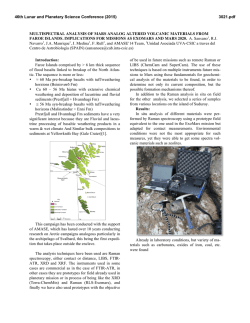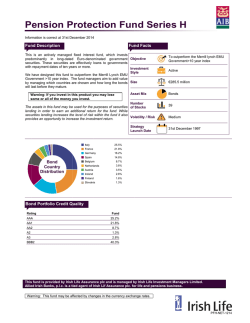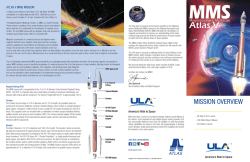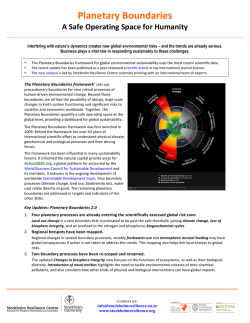
THE SPACE LAUNCH SYSTEM AND MISSIONS - USRA
46th Lunar and Planetary Science Conference (2015) 2346.pdf THE SPACE LAUNCH SYSTEM AND MISSIONS TO THE OUTER SOLAR SYSTEM. K. Klaus1, 1The Boeing Company (13100 Space Center Blvd., Houston TX, 77059, [email protected]). Introduction: America’s new heavy lift launch vehicle, the Space Launch System (SLS), enables a variety of planetary science missions. In addition to human space flight, the SLS can be used for most, if not all, of the National Research Council’s (NRC) Planetary Science Decadal Survey missions to the outer planets. [1] The SLS performance enables larger payloads and faster travel times with reduced operational complexity when compared to the original concept studies. We will outline a number of mission concepts drawn from the Decadal Survey. All of our studies are preliminary and used the spacecraft designs from the mission concept studies submitted to the NRC. The exception to this is the Europa Clipper mission which came about as a descope of the Jupiter Eurpoa Orbiter that was originally part of the EJSM Flagship mission. Our goal is to investigate what the capabilities of the SLS would bring to these important science missions. Europa Clipper: Our analysis shows that a launch on the SLS would shorten the Clipper mission travel time by more than four years over earlier mission concept studies [2]. The direct ballistic trajectory eliminates the need for Venus and Earth flybys, simplifying overall mission design. The SLS provides sufficient launch mass margin allowing for increased radiation shielding mass as well as expansion of the science payload. Using the SLS for the Europa mission will provide a model for other outer planet missions. Jupiter Trojan Tour and Rendezvous: Our mission concept replaces unavailable Advanced Stirling Radioisotope Generators (ASRGs) in the original design with solar arrays. Our new approach allows for a much broader target selection: all of the L4s and some of the L5s are available targets. The SLS capability allows for extra tankage for more propellant, yields twice the delta-v of the original mission design, and offers many more target opportunities. [3] Comet Surface Sample Return: Although in our mission concept, the SLS launches later than the NRC mission study (November 2022 instead of the original launch date of January 2021), it reduces the total mission time, including sample return, by two years. [4] The direct trajectory simplifies mission operations. The improved launch mass margin allows for increased propellant, sample return mass, or science payload for in situ investigations at the target. Saturn Apmospheric Entry Probe: Though Saturn arrivial time remains the same in our concept as the arrival date in the NRC study (2034), launching on the SLS shortens the mission travel time by three years with a direct ballistic trajectory. [5] This eliminates the 46th Lunar and Planetary Science Conference (2015) need for Earth flyby and a deep space burn maneuver, simplifying overall mission design and reducing operational cost. The improved launch mass margin allows for increased science payload, such as additional probes, and potential orbital science opportunities at Enceladus or Titan. Uranus Orbiter with Probes: The SLS shortens travel time for an Uranus mission by four years with a Jupiter swing-by trajectory. It removes the need for a solar electric propulsion (SEP) stage used in the NRC mission concept study. [6] The improved launch mass margin allows for increased science payload such as an additional probe and more propellant for an extended Uranus system tour. Other SLS Science Mission Candidates: Two other mission concepts we are investigating that may be of interest to this community are the Advanced Technology Large Aperature Space Telescope (ATLAST) and the Interstellar Explorer also referred to as the Interstellar Probe. ATLAST. The ATLAST 16 m enables the characterization of exoplanets and the search for extrasolar life. It allows scientists to explore the modern uni- 2346.pdf verse, investigate super massive black holes (SMBH), reconstruct the stellar history of hundreds of galaxies and measure the mean density profile of dwarf spheroidal galaxies (dSph) to constrain the nature of dark matter. The SLS is the only vehicle capable of deploying telescopes of this mass and size in a single launch. It simplifies mission design and reduces risks by eliminating the need for multiple launches and in-space assembly. Interstellar Explorer. The concept of a probe to the interstellar medium grew from the studies that accompanied the initial planning for a “Grand Tour” mission to the outer planets of the solar system. In 1976 a study was undertaken at the Jet Propulsion Laboratory (JPL) of an “interstellar precursor mission” as a stepping-stone from the outer solar system to interstellar flight. The ultimate reach of the Voyagers is limited and it is clear that further progress requires a faster, deeper probe of near interstellar space. While many exotic approaches to rapid, solarsystem escape have been discussed over the past four decades, none of these is currently sufficiently advanced to implement on a mission during the next 10 to 15 years. However, with a new capability (the Exploration Upper Stage) being considered for the NASA Space Launch System (SLS) extremely large launch injection energies (C3s 200 km2/s2 to 350 km2/s2) should be possible for an Interstellar Probe. [7] Summary: The first launch of the SLS is scheduled for 2018 followed by the first human launch in 2021. The SLS in its evolving configurations will enable a broad range of exploration missions which will serve to recapture the enthusiasm and commitment that permeated the planetary exploration community during the early years of robotic exploration. [8] NASA and the International Exploration Community should explore ways to utilize the SLS for Planetary Science Missions. The world needs a launch vehicle with the performance that today only the SLS will provide. References: [1] The Committee on the Planetary Science Decadal Survey, Visions and Voyages for Planetary Science in the Decade 2013-2022. (2011), 4-7. [2] Goldstein B. et al. (2014) Europa Clipper Update, SBAG, p. 10. [3] Brown M. (2010) Trojan Tour Decadal Study, 2143. [4] Veverka J. et al., (2010) Comet Surface Sample Return (CSSR) Mission, 6-20. [5] Beebe R. et al., (2010) Saturn Atmospheric Entry Probe Mission Study, 9-20. [6] Hubbard W. B. et al., (2010) Ice Giants Decadal Study, 19-48. [7] McNutt R. L. et al. (2014) Enabling Interstellar Probe With The Space Launch System (SLS), IAC-14-D4.4.2. [8] Elsperman M. S. and Klaus K. (2014) IAA WAS0210.
© Copyright 2025







![[7590-01-P] NUCLEAR REGULATORY COMMISSION [Docket Nos](http://s2.esdocs.com/store/data/000481426_1-2410dc333214cc96062b45f6b0492ee5-250x500.png)